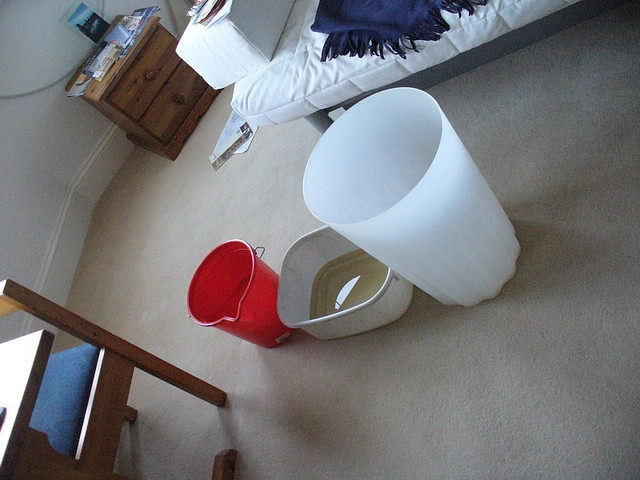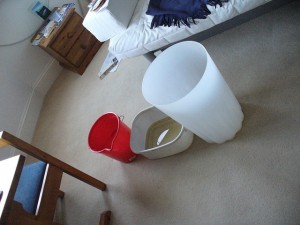
Leaky Roof? Find the Source of Your Roof Damage Before Trying to Repair It
As today’s guest writer shares, finding the source of your leak is incredibly important in repairing your leak, restoring roof damage and preventing further water damage to your home or building.
Fixing that leaky roof properly is also important. As licensed Public Adjusters in Miami, we’ve seen hundreds (if not thousands) of roof repairs that were not done properly in order to save money – and only ended up causing more property damage and costing more money.
Our suggestion, just like today’s writer, is to find the true source of the leak and get it properly repaired. With our thorough property damage assessment and our processes to file an insurance claim, we can get you the money you need to complete the repairs.
The Single Most Important Question Regarding a Roof Leak Repair
 There’s no teaser with this article or any waiting until the last paragraph to tell you the answer. Here it is right up front: The Single Most Important Question Regarding a Roof Leak Repair – Why is it leaking?
There’s no teaser with this article or any waiting until the last paragraph to tell you the answer. Here it is right up front: The Single Most Important Question Regarding a Roof Leak Repair – Why is it leaking?
Too simple? Are you thinking that you obviously would do that? Maybe. Hopefully. But in reality, many people do not ask themselves this fundamental question, whether DIY homeowners, handymen, general contractors or even, (gasp) roofers.
How can I say that? Easy. By looking at the types of repairs we have seen done by others. Needless to say, these repairs solved little and required more work to solve the problem. Having said that, I’ll excluded true emergency repairs from the analysis. Everyone gets a pass when it’s pouring down two inches per hour and most of that is ending up in your living room. In such cases, anything that temporarily stops the leak until it isn’t raining (or at least not raining as hard) is free of criticism, unless it somehow causes even more harm to the roof.
But what I’m talking about are poorly done, medium to long-term repairs. Basically, we often see the roofing equivalent of putting a tourniquet on a leg for seeing a little blood on a sock without ever having taking the sock off to see the cause. Without a competent effort to see what actually is causing the leak, simply covering up everything within 10 ft of the assumed leak zone with tar will not solve the underlying problem.
So here are some things we have seen that as a general rule, should never be used for a long-term repair:
- Gallons of tar or sealant
- A patch of new shingles directly on top of the old roof
- Tin shims slid underneath cedar shakes or tiles
- And the always ugly “originally temporary but now permanent” tarps.
In addition to these externally visible attempts, many repairs that simply replace existing materials with new ones might not solve anything. Roofs are not like PCs – a reboot doesn’t magically make it work again. You need to find the problem. The one exception would be where the original roof was installed properly but the old materials have literally worn through – in this case, yes, new materials can solve a problem.
So now that we have focused on a few common signs of a poorly or never diagnosed roof leak repair, let’s briefly look at some of the areas to included in your review of the leaking roof.
Always start with looking at roof vents, pipe flashings and skylights. These are areas where there is literally a hole in the roof. Everything must be installed perfectly in these areas for them to remain watertight. Pipe flashings in particular can be both a common and an easy repair. Since these days most are sealed with self fitting “rubber pipe boots” that are subject to quicker UV deterioration than the rest of the roof, these generally will fail much earlier that the roof itself. Every time you have your roof maintained you need to be sure that someone is checking bootjacks for you.
Sometimes the cause of the leak is unique to the type of roof you have. For instance, tile roofs, especially when rounded, tend to get leaks in their valleys much more that asphalt composition and cedar roofs. Why? Because of the extra height of the tiles that allows for tree debris to more easily pack underneath them. In turn, this debris them acts as a dam to back up rainwater that should be running down the valley. Simply assuming that there was a problem with the valley metal would be a diagnosis that could result in hundreds or thousands of dollars spent fixing something that is not broken.
Leaks near chimneys need to be reviewed closely to determine whether it is a roof issue or a masonry issue (if you have a brick chimney.) A lot of effort and expense can be thrown into either repair only to still have a leak. Sign that the leak might not be related to the roof would be if you are able to determine is water is also coming down the inside of the chimney as well as the outside (even though the outside of the chimney wall may still be inside of the house.)
Cracked and missing grout is also a very strong indicator of a chimney leak source. If moss is growing in grout, scrape it away and check the condition. Finally, any cracked bricks or loose or rusted chimney caps point to a chimney cause of the leak. Conversely, any loose or detached flashing that are supposed to be secured to the chimney itself point to a repair that will involve needing to lift up some roofing to re-flash the problem.
Much like a transmission that is making a clanking noise, a roof leak occasionally cannot be determined without tearing it open. Simply tarring over it will accomplish very little, other than making your roof look hideous. A gap in the underlying felt, the absence of a water/ice barrier or a too short of a valley flashing are all examples of problems that could not be determined by an exterior examination only. A reputable roofer should always allow you to apply the cost of the exploratory work towards the final repair if you choose to proceed with them.
While it is certainly tempting to think a quick and easy repair will solve your roof leak, that thought is often far from reality. Spend the time investigating and do not start your repair until you or your professional are very certain that you have found the cause of the leak.
— Ana Lamb, All Surface Roofing and Construction
###
Thanks to Ana for sharing her roof repair knowledge with us!
If you have a leaky roof in the Miami, FL area – give us a call and we can help you fully assess the damage and file an insurance claim that will sufficiently fund a proper roof repair.
About the Author – All Surface Roofing and Construction is an award winning, Portland Oregon family owned business. We are one of two closely interrelated divisions. All Surface Cleaning Company works primarily on roof cleaning, restoring roofs, decks, gutters, and All Surface Roofing and Construction is involved in slightly larger projects, such as roof installation and replacement. Call Portland Roofing at 503-598-7404 for a reliable Portland Roof Contractor .
Photo Credit: http://www.flickr.com/photos/handolio/4172044443/






